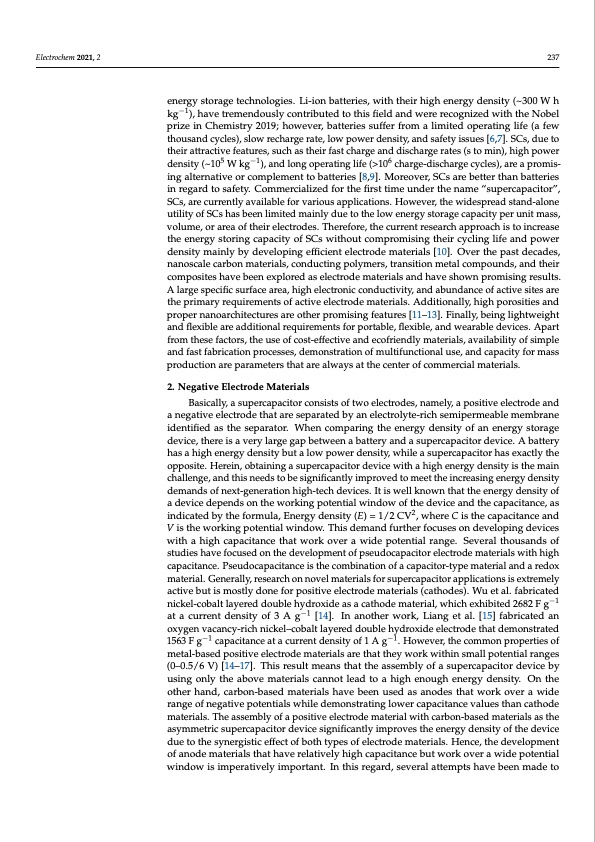
PDF Publication Title:
Text from PDF Page: 002
Electrochem 2021, 2 237 energy storage technologies. Li-ion batteries, with their high energy density (~300 W h kg−1), have tremendously contributed to this field and were recognized with the Nobel prize in Chemistry 2019; however, batteries suffer from a limited operating life (a few thousand cycles), slow recharge rate, low power density, and safety issues [6,7]. SCs, due to their attractive features, such as their fast charge and discharge rates (s to min), high power density (~105 W kg−1), and long operating life (>106 charge-discharge cycles), are a promis- ing alternative or complement to batteries [8,9]. Moreover, SCs are better than batteries in regard to safety. Commercialized for the first time under the name “supercapacitor”, SCs, are currently available for various applications. However, the widespread stand-alone utility of SCs has been limited mainly due to the low energy storage capacity per unit mass, volume, or area of their electrodes. Therefore, the current research approach is to increase the energy storing capacity of SCs without compromising their cycling life and power density mainly by developing efficient electrode materials [10]. Over the past decades, nanoscale carbon materials, conducting polymers, transition metal compounds, and their composites have been explored as electrode materials and have shown promising results. A large specific surface area, high electronic conductivity, and abundance of active sites are the primary requirements of active electrode materials. Additionally, high porosities and proper nanoarchitectures are other promising features [11–13]. Finally, being lightweight and flexible are additional requirements for portable, flexible, and wearable devices. Apart from these factors, the use of cost-effective and ecofriendly materials, availability of simple and fast fabrication processes, demonstration of multifunctional use, and capacity for mass production are parameters that are always at the center of commercial materials. 2. Negative Electrode Materials Basically, a supercapacitor consists of two electrodes, namely, a positive electrode and a negative electrode that are separated by an electrolyte-rich semipermeable membrane identified as the separator. When comparing the energy density of an energy storage device, there is a very large gap between a battery and a supercapacitor device. A battery has a high energy density but a low power density, while a supercapacitor has exactly the opposite. Herein, obtaining a supercapacitor device with a high energy density is the main challenge, and this needs to be significantly improved to meet the increasing energy density demands of next-generation high-tech devices. It is well known that the energy density of a device depends on the working potential window of the device and the capacitance, as indicated by the formula, Energy density (E) = 1/2 CV2, where C is the capacitance and V is the working potential window. This demand further focuses on developing devices with a high capacitance that work over a wide potential range. Several thousands of studies have focused on the development of pseudocapacitor electrode materials with high capacitance. Pseudocapacitance is the combination of a capacitor-type material and a redox material. Generally, research on novel materials for supercapacitor applications is extremely active but is mostly done for positive electrode materials (cathodes). Wu et al. fabricated nickel-cobalt layered double hydroxide as a cathode material, which exhibited 2682 F g−1 at a current density of 3 A g−1 [14]. In another work, Liang et al. [15] fabricated an oxygen vacancy-rich nickel–cobalt layered double hydroxide electrode that demonstrated 1563 F g−1 capacitance at a current density of 1 A g−1. However, the common properties of metal-based positive electrode materials are that they work within small potential ranges (0–0.5/6 V) [14–17]. This result means that the assembly of a supercapacitor device by using only the above materials cannot lead to a high enough energy density. On the other hand, carbon-based materials have been used as anodes that work over a wide range of negative potentials while demonstrating lower capacitance values than cathode materials. The assembly of a positive electrode material with carbon-based materials as the asymmetric supercapacitor device significantly improves the energy density of the device due to the synergistic effect of both types of electrode materials. Hence, the development of anode materials that have relatively high capacitance but work over a wide potential window is imperatively important. In this regard, several attempts have been made toPDF Image | Review of Electrospun Carbon Nanofiber-Based Negative Electrode Materials

PDF Search Title:
Review of Electrospun Carbon Nanofiber-Based Negative Electrode MaterialsOriginal File Name Searched:
A_Review_of_Electrospun_Carbon_Nanofiber-Based_Neg.pdfDIY PDF Search: Google It | Yahoo | Bing
Sulfur Deposition on Carbon Nanofibers using Supercritical CO2 Sulfur Deposition on Carbon Nanofibers using Supercritical CO2. Gamma sulfur also known as mother of pearl sulfur and nacreous sulfur... More Info
CO2 Organic Rankine Cycle Experimenter Platform The supercritical CO2 phase change system is both a heat pump and organic rankine cycle which can be used for those purposes and as a supercritical extractor for advanced subcritical and supercritical extraction technology. Uses include producing nanoparticles, precious metal CO2 extraction, lithium battery recycling, and other applications... More Info
| CONTACT TEL: 608-238-6001 Email: greg@infinityturbine.com | RSS | AMP |